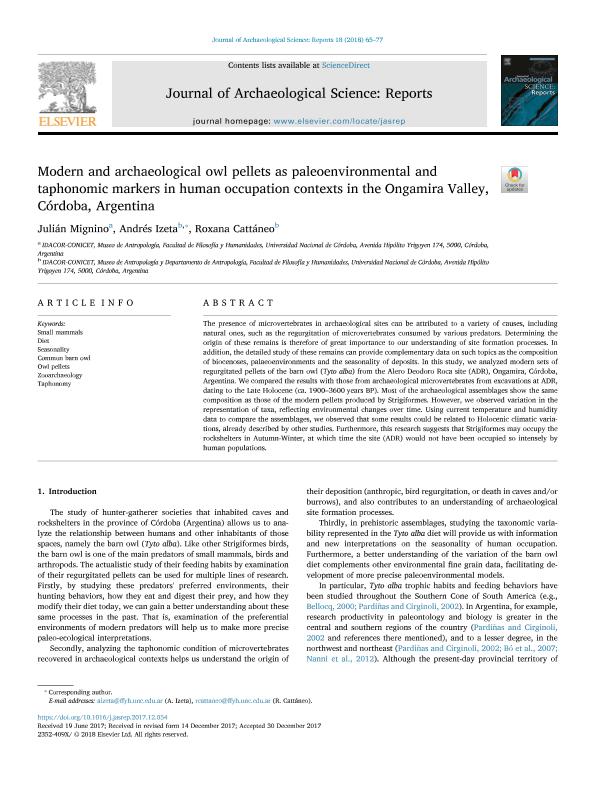Artículo
Modern and archaeological owl pellets as paleoenvironmental and taphonomic markers in human occupation contexts in the Ongamira Valley, Córdoba, Argentina
Fecha de publicación:
04/2018
Editorial:
Elsevier Ltd
Revista:
Journal of Archaeological Science: Reports
ISSN:
2352-409X
Idioma:
Inglés
Tipo de recurso:
Artículo publicado
Clasificación temática:
Resumen
The presence of microvertebrates in archaeological sites can be attributed to a variety of causes, including natural ones, such as the regurgitation of microvertebrates consumed by various predators. Determining the origin of these remains is therefore of great importance to our understanding of site formation processes. In addition, the detailed study of these remains can provide complementary data on such topics as the composition of biocenoses, palaeoenvironments and the seasonality of deposits. In this study, we analyzed modern sets of regurgitated pellets of the barn owl (Tyto alba) from the Alero Deodoro Roca site (ADR), Ongamira, Córdoba, Argentina. We compared the results with those from archaeological microvertebrates from excavations at ADR, dating to the Late Holocene (ca. 1900–3600 years BP). Most of the archaeological assemblages show the same composition as those of the modern pellets produced by Strigiformes. However, we observed variation in the representation of taxa, reflecting environmental changes over time. Using current temperature and humidity data to compare the assemblages, we observed that some results could be related to Holocenic climatic variations, already described by other studies. Furthermore, this research suggests that Strigiformes may occupy the rockshelters in Autumn-Winter, at which time the site (ADR) would not have been occupied so intensely by human populations.
Archivos asociados
Licencia
Identificadores
Colecciones
Articulos(IDACOR)
Articulos de INSTITUTO DE ANTROPOLOGIA DE CORDOBA
Articulos de INSTITUTO DE ANTROPOLOGIA DE CORDOBA
Citación
Mignino, Julian; Izeta, Andres Dario; Cattaneo, Gabriela Roxana; Modern and archaeological owl pellets as paleoenvironmental and taphonomic markers in human occupation contexts in the Ongamira Valley, Córdoba, Argentina; Elsevier Ltd; Journal of Archaeological Science: Reports; 18; 4-2018; 65-77
Compartir
Altmétricas




